Surely you have seen small local businesses giving back to the community. Maybe they sponsor local events, pay for the high school sports teams’ uniforms, or host galas and fundraisers to help local charities. Now you might be wondering if this is something your business should do. Think of it this way: neighborhoods are like balanced ecosystems, where your business is a natural component of the overall structure. The customers, employees, and vendors are all part of the same community and are crucial to your business’s growth. Therefore, a healthy and robust ecosystem is vital for success; and you can help make that happen by giving back to the community.

It is essential to understand that businesses are based on relationships, and relationships are based on people. So, why not develop long-lasting relationships by giving back to the community and supporting the people who, in return, will support your business? Not only is it the right thing to do, but a connection between your business and the community builds “social capital,” which is the goodwill generated by community involvement (Adler & Kwon, 2002.) When companies work to help with issues that may be affecting the community, such as blood drives, feeding the homeless, and donating to schools, their actions help build social capital.
The business and community groups develop close relationships, and all parties involved become more committed to each other’s well-being. Many experts believe that high social capital levels enhance a community’s quality of life, producing a win-win result. This positively affects every individual in the community one way or another. Social capital also creates a sense of trust and loyalty towards your brand, which are priceless commodities and are essential for any small business to achieve longevity successfully.
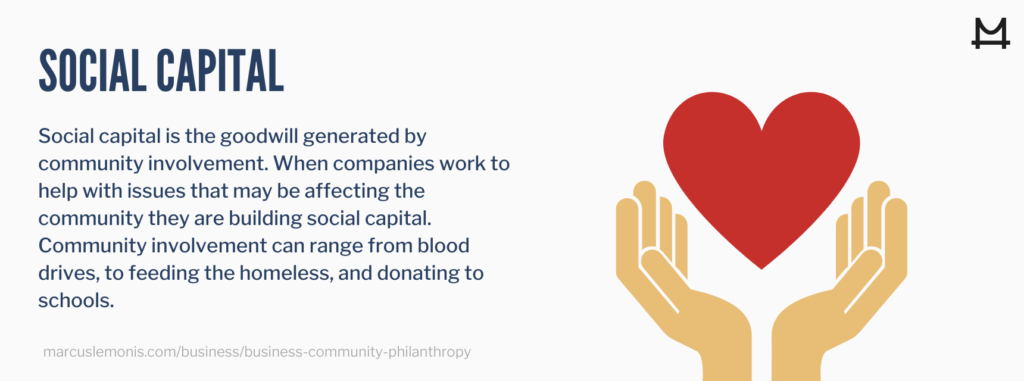
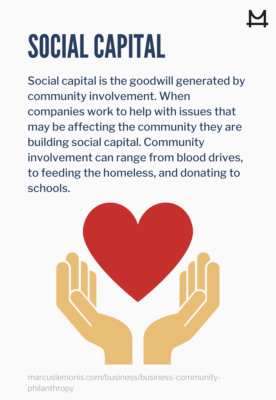
- Customers wish for the assurance of high-quality and safe products and services.
- Employees want fair wages and benefits and a safe and pleasant working environment.
- The community wants assurance that your business is a good neighbor that gives back to the community.

Your business’s reputation for possessing these attributes translates into increased social capital, which leads to organizational success and, ultimately, increased profitability—a concept to which some have referred to as a triple-bottom-line: People, Planet & Profits (Tsetsura & Kruckeberg, 2009.) It is understandable if you believe that the concept of social capital is too abstract for your business, so here are some real and substantial numbers:
- People: According to a Boston College study, 80% of HR managers reported that community involvement helped them retain talent, thus translating to higher employee retention. Also, it has been proven that giving back to the community helps to bond your teams: “64% of surveyed employees bonded and built stronger connections while volunteering together” (UnitedHealth Group.) On March 24, 2020, Camping World announced that Marcus Lemonis would use personal funds to assist Camping World employees experiencing financial difficulties due to COVID-19.
By selling up to 500,000 shares of Class A common stock that he beneficially owned, he contributed to the company’s employee relief fund. Marcus understands that by taking care of his employees, they would be in a better position to take care of their clients. In his own words, “The customer is not No. 1 to me. They’re No. 2, right behind the employee […] We are in unprecedented times, and we are all making sacrifices; but it is important for us all to do more, and I’m reaching into my pocket to protect the team.”
By tackling his employees’ cash flow challenge, Marcus also indirectly helps other local businesses by injecting spending power into the community at large.
- Planet: Sustainable organizations also recognize that “profit” isn’t entirely opposed to “people” or “planet.” In 2016, Swedish furniture giant IKEA turned a profit by recycling waste and turning it into some of its best-selling product lines.

Before this change, getting rid of the waste had cost the company more than $1 million per year. Now, the company is well on its way to “zero waste to landfill” worldwide. According to Joanna Yarrow, IKEA’s head of sustainability for the UK, “We don’t do this because we’re tree huggers, we do this because it’s very cost-effective.” It’s a win-win. Helping the planet, keeping your community clean, and developing a sense of environmental responsibility could also mean significant savings or new revenue sources for your small business. Look for ways in which sustainability could also help your bottom line; this is key on how to give back to the community as a business.
- Profits: A recent McKinsey analysis determined that “30 percent of corporate earnings are affected by the company’s reputation with external stakeholders,” (Enright & Taylor, 2016,) thus, measurably increasing your business’s value. Different social programs could boost profits directly by increasing foot traffic to your business, expanding the reach of your word of mouth, and increasing sales by offering your services in other spaces such as school events or community fairs, for example. Keep in mind your target audience and find common ground when thinking about how to give back to the community as a business. This will help increase the return of investment (ROI) as you are giving back to the community – everybody wins.
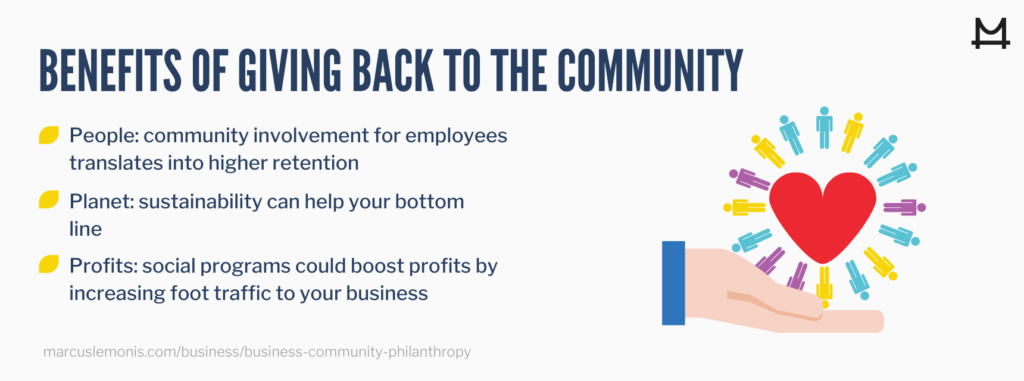
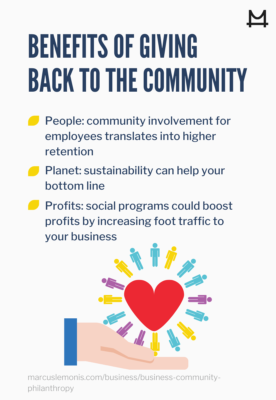
How to Give Back to the Community as a Business.
Now that you realize that giving back to the community is a good idea, you may be wondering how to give back to the community as a business. First, don’t compromise who you are. To help your community in the best way possible, you must find a real problem and see how your business can be part of the solution. Second, as mentioned before, you must consider your target audience. Focus your efforts on your potential customer. For example, you shouldn’t host a vegan food festival for local farmers if you own a butcher shop. Your efforts should always be honest and align with your business’s core values and your philanthropic position. If you wish to tackle a problem in your community that may not harmonize with your business, feel free to do so as an individual under your name, not your company. For example, if you wish to sponsor your kid’s soccer team, but you own a bar, it would be best to make a personal donation instead of having the bar be the sponsor.
Community Involvement Ideas for Businesses.
When implementing solutions in your community with the help of your team, try to recruit community volunteers. Remember that ultimately, the idea behind these efforts is to solve a community problem by joining forces with its people. So, getting the public involved as your small business spearheads an effort to give back to the community is going to make it that much more impactful and overall successful in building goodwill between your business and the people. Here are some simple community involvement ideas for businesses:

- Host a volunteer day for employees. Get your employees into the spirit of giving back. You can partner with local nonprofit organizations and have a volunteer day where your employees help in the community instead of coming into work. For example, Marcus’s desire to give back has led to the company-wide adoption of an employee volunteer program, Project Good Samaritan. In 2013, Camping World and Good Sam made it a condition of employment that every associate dedicates eight hours per quarter of company-paid time to volunteer for meaningful causes. This is one way to have your team become engaged with building fellowship by giving back to the community in ways aligned to their personal beliefs.
-
- Offer donation matching. Promote a fundraising campaign through your business and offer to match your team members’ and clients’ monetary donations up to a specific pre-set amount. Encourage participation by creating a visual aid where everyone can see how much employees or clients have contributed and how much the business has matched.
-
- Share your space. Some interesting community involvement ideas for businesses could involve you opening your doors to the community. If your company has a physical space, offer it free of charge for an event or meeting. This helps nonprofits save money. It’s also another way to give your business visibility—since it brings people right into your space. Even think of your business’s equipment, since it may be useful to an organization. Maybe if you have a commercial kitchen, you could offer the space after business hours for a group of volunteers to cook for the homeless or the local school’s Parent Teacher Association to come in and bake for a fundraiser.
-
- Sponsor a fundraiser or charity. When new small business owners ask themselves, how to give back to the community as a business, this is usually the first thing that comes to mind. Logistically it is effortless; it just requires cash flow. You can have your business champion a cause, become the face of a charity, or consider donating money to offset an event’s costs. These are all typical community involvement ideas for businesses.
-
- Sponsor a fundraiser or charity. When new small business owners ask themselves, how to give back to the community as a business, this is usually the first thing that comes to mind. Logistically it is effortless; it just requires cash flow. You can have your business champion a cause, become the face of a charity, or consider donating money to offset an event’s costs. These are all typical community involvement ideas for businesses.

- Highlight a local organization. Another community involvement idea for your business is to use your voice through your marketing channels to bring attention and create awareness of a specific challenge the community may be experiencing or to a local organization that may need exposure. Your business can hold an event or host a gala or block party for a local organization and make sure it gets media coverage. You can also use your storefront to display banners or billboards, and even have your customer-facing personnel wear pins or buttons that bring attention to the cause. Another way you can give back to the community as a business is by having a designated day of the week or month where a percentage of proceeds go to the charity you’re championing.
Big brands like Apple, Dannon, Durex, and Vespa have also wondered how to give back to the community as a business. And one of the ways they are giving back to the community has been by partnering up with (PRODUCT)RED. In Apple’s case, there is a specific iPhone in their lineup, the SE (PRODUCT)RED, where 100% of the proceeds from the sales go to the Global Fund to fight AIDS. Your business might not be as big as these brands to collaborate with (RED) on a global effort; but you could still learn from their model and have a specific menu offering or a particular item of merchandise that, whenever purchased, a donation gets made to your cause.
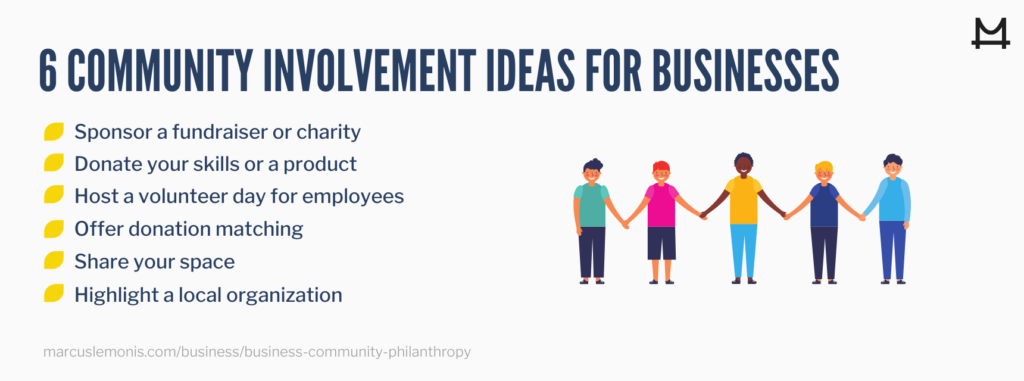

As you can see, there are no one-size-fits-all community involvement ideas for businesses. Numerous variables affect what you can do to make your small business part of an inclusive economy. From business type, size, budget, and specific community demands, more needs to be considered. But at the end of the day, the key to business isn’t being smarter or wealthier; it’s being able to connect to people and relate to them. As a business owner, you have a responsibility to embrace your community’s needs and understand that customer engagement is key to your business’s purpose and success. Through more collaborative, inclusive, and strategic engagement with your community, your small business success will grow as you increase your social capital. By giving back to the community, all individuals and organizations can participate in, benefit from, and contribute to their local economies.

So, no matter how you decide to use your business to give back locally, you can build a positive reputation while having a long-lasting impact on your community that will, in return, benefit your business. But remember that companies cannot do it all alone: these efforts need to be a joint activity where your employees and the community, along with your leadership, can all come together and work towards achieving a unified goal. Many companies are starting to take the lead in this new humanitarian way of doing business. Now, imagine what the world would be like if all companies prioritized their communities and valued their employees’ and customers’ well-being enough to make a constant effort to improve it. Beautiful right? Success usually is. Have no fear and be willing to fail. You can do this.
- How does your business give back to the community?
- What impact has community involvement had on your business?
Adler, P. S., & Kwon, S. (2002). Social Capital: Prospects for a New Concept. The Academy of Management Review, 27(1), 17. doi:10.2307/4134367
Enright, S., & Taylor, A. (2016). (rep.). The Future of Stakeholder Engagement. BSR.
Hillman, A., & Keim, G. (2001). Shareholder Value, Stakeholder Management, and Social Issues: What’s the Bottom Line? Strategic Management Journal, 22(2), 125-139. Retrieved June 28th, 2020, from www.jstor.org/stable/3094310
Tsetsura, K., & Kruckeberg, D. (2009). Corporate Reputation: Beyond Measurement. Public Relations Journal, 3(3).





